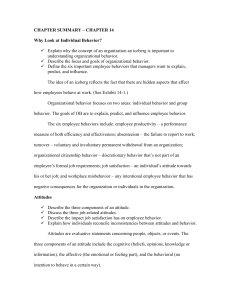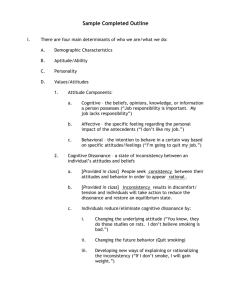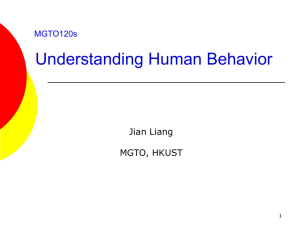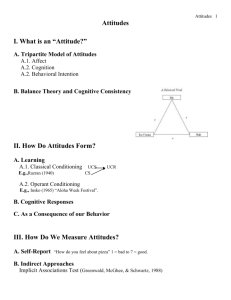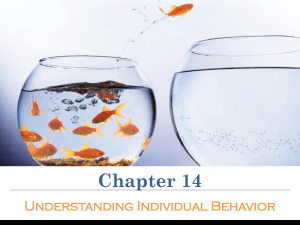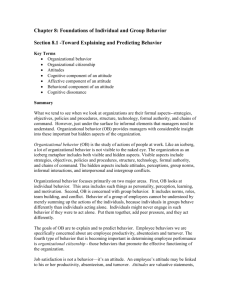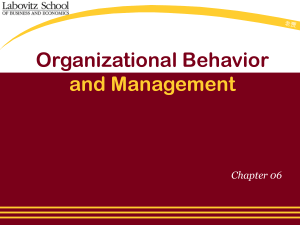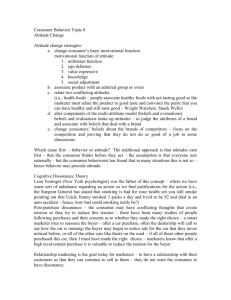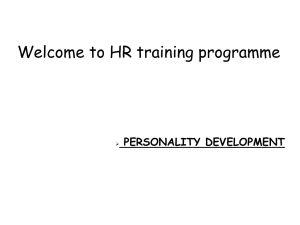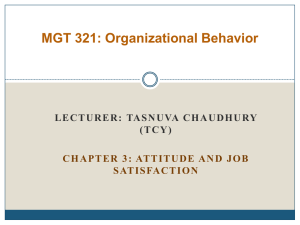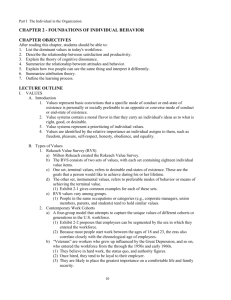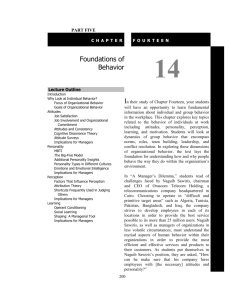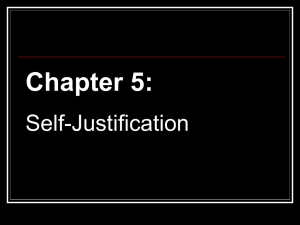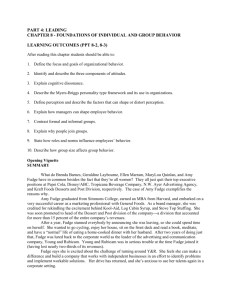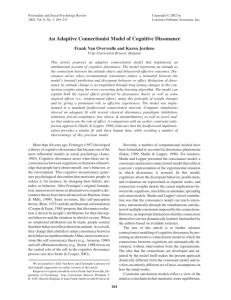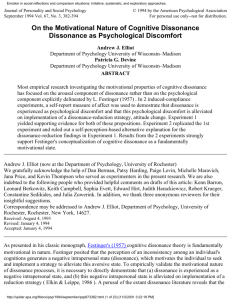The attitude
advertisement
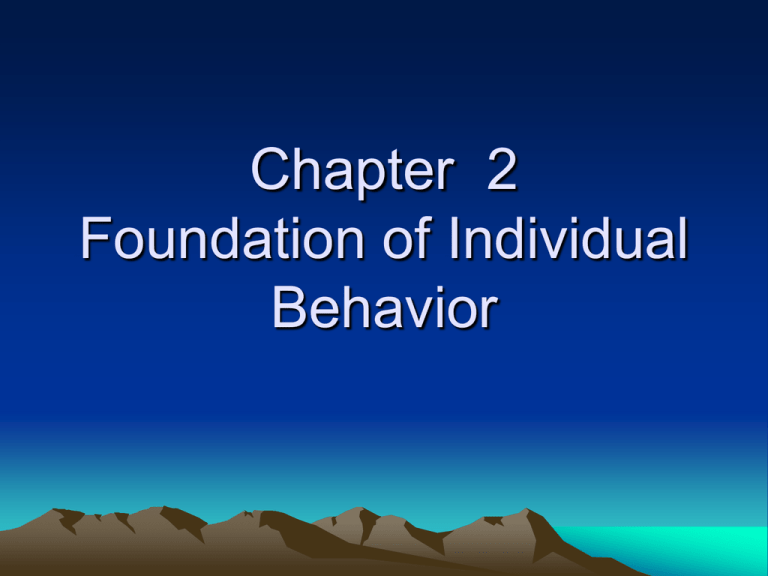
Chapter 2 Foundation of Individual Behavior goals • 1. List the dominant values in today’s workforce • 2. Describe the relationship between satisfaction and productivity • 3. Explain the theory of cognitive dissonance • 4. Summarize the relationship between attitude and behavior • 5. Explain how two people can see the same thing and interpret it differently • 6. Summarize attribution theory A—Personality • Our personality shape our behavior. • Why are some people quiet and passive, while others are loud and aggressive? • Are certain personality types better adapted than others for certain job types? Defining Personality • Gordon Allport : • Personality is the dynamic organization within the individual of those psychophysical systems that determine his unique adjustments to his environment. • Personality is the sum total of ways in which an individual reacts to and interacts with others. Personality Determinants • Heredity – Physical stature – Facial attractiveness – Gender – Temperament – Muscle composition and reflexes – Energy level – Biological rhythms • Environment Personality traits(人格特质) • Enduring characteristics: – Shy – Aggressive – Submissive – Lazy – Ambitious – Loyal – timid The Myers- Briggs Type Indicator 迈尔斯-布里格斯类型指标(MBTI) • MBTI is the most widely used personalityassessment instrument in the world. • Extroverted / Introverted (外向/内向型)E/I • Sensing / Intuitive (领悟/直觉型)S/N • Thinking / Feeling (思维/情感型)T/F • Judging / Perceiving (判断/感知型)J/P • These classifications together describe 16 personality types. • http://www.apesk.com/mbti/dati.asp The Big Five Personality Model • Extraversion (外倾性) – Extraverts: gregarious, assertive, sociable – Introverts: reserved, timid, queit • Agreeableness (随和性) – High: cooperative, warm, trusting – Low: cold, disagreeable, antagonistic • Conscientiousness (责任心) – High: responsible, organized, dependable, persistent – Low: easily distracted, disorganized, unreliable • Emotional stability (情绪稳定性) – Positive: calm, self-confident, secure – Negative: nervous, anxious, depressed, insecure • Openness to experience (经验的开放性) – High: creative, curious, artistically sensitive – Low: conventional, find comfort in familiar Type A Personality(A型人格) • Type A’s: • 1. are always moving, walking, and eating rapidly; • 2. feel impatient with the rate at which most events take place; • 3. strive to think or do two or more things at once, • 4. cannot cope with leisure time; • 5. are obsesses with numbers, measuring their success in term of how many or how much of everything they acquire. • Type A’s operate under moderate to high level of stress. • Type A’s do better than Type B’s in job interviews. Self- monitoring(自我监控) • Self- monitoring refers to an individual’s ability to adjust his or her behavior to external, situational factors. • High self-monitors are highly sensitive to external cues and can behave differently in different situations. • They are capable of presenting striking contradictions between their public persona and their private self. B—Values • Values----basic convictions • “A specific mode of conduct or end-state of existence is personality or socially preferable to an opposite or converse mode of conduct end-state of existence”. • Values have both content and intensity attributes. • Content----important • Intensity----how important • Value system represent a prioritizing of individual values. • All of us have a hierarchy or values that forms our value system. • They’re identified by the relative importance an individual assigns to values such as freedom, pleasure, self-respect, honesty, obedience, and equality. Type of values • Rokeach value survey(罗克奇价值观调查) • Terminal values(终极价值观)- refers to desirable end-states of existence. These are the goals that a person would like to achieve during his or her lifetime. • Instrumental values(工具价值观)refers to preferable modes of behavior, or means or achieving the terminal values. Terminal values • • • • • • • • • • • • Instrumental Values A comfortable life Ambitious A sense of accomplishment Capable A world of peace Cheerful A world of beauty Clean Equality Courageous Family security Helpful Happiness Honest Inner harmony Imaginative Pleasure Logical Salvation Obedient Social recognition Polite True friendiship Responsible • Contemporary Work Cohorts • (当代工作群体) Cohort Entered the workface Approximate Current Age Veterans 1950s or 70 + 退伍军人)early 1960s Boomers 1965-1985 45 - 60+ 婴儿潮一 代 Xers 1985-2000 30 - 45 X世代 Nexters 2000 to 下一世代 present 30 Dominate work values Hard working, conforming, conservation, loyalty to the organization, Success, achievement, ambition, dislike of authority, loyalty to career Work/like balance, teamoriented, dislike of rule, loyalty to relationships Confident, financial success, self-reliant but team- oriented, loyalty to both self and R Values Across Cultures • A Framework for Assessing Cultures • 1970s Geert Hofstede • Five value dimensions of national culture • • • • • Power distance Individualism vs. collectivism Quantity of life vs. quality or life Uncertainty avoidance 不确定性规避 Long- term vs. short- term orientation • Not all OB theories and concepts are universally applicable to managing people around the world. • You should take into consideration cultural values when trying to understand the behavior of people in different countries. C — Attitudes • Attitudes are evaluative statements ---either favorable or unfavorable ---concerning objects, people, or events. • Researchers have assumed that attitudes have three components: • cognition, affect, and behavior. • Viewing attitudes as being made up of three components ---- cognition, affect and behavior---- is helpful in understanding their complexity and the potential relationship between attitudes and behavior. • These components are closely related, and cognition and affect in particular are inseparable in many ways. • Does behavior always follow from attitudes? • Early---- behavior follow attitudes • In the late 1960s---- attitude follow behavior • Leon Festinger 1950s • Cognitive dissonance (认知失调) • Cognitive dissonance refers to any incompatibility an individual might perceive between two or more attitudes or between behavior and attitudes. • The theory of cognitive dissonance suggests that people seek to minimize dissonance and the discomfort it causes. • A person’s desire to reduce dissonance, is determined by • (1) the importance of the elements creating the dissonance, • (2) the degree of influence the individual believes he or she has over the elements, • and (3) the rewards that may be involved in dissonance. • Path: • A: change you behavior • B: conclude that the dissonant behavior is not so important • C: change you attitude • D: seek out more consonant elements to outweigh the dissonant ones • The degree of influence that individuals believe they over the elements will have an impact on how they will react to the dissonance. • Rewards also influence the degree to which individuals are motivated to reduce dissonance. • Organizational implications: • The theory of cognitive dissonance can help to predict the propensity to engage in both attitude and behavior change. • The attitude/ behavior relationship: • Moderating Variables(调节变量) – The importance of the attitude – Its correspondence to behavior – Its accessibility – Whether there exist social pressures – Whether a person has direct experience with the attitude • Self-perception theory(自我知觉理论) the major job-related attitudes • Job satisfaction(工作满意度) • Job involvement(工作参与度) • Organizational commitment • (组织承诺) • Job satisfaction • Job satisfaction refers to an individual’s general attitude toward his or her job. • Determines : – Mentally challenging work (moderate) – Equitable rewards – Supportive working conditions – Supportive colleagues – tangible • Job involvement measures the degree to which people identify psychologically with their job and consider their perceived performance level important to self-worth. • Psychological empowerment(心理授权) is employees’ beliefs in the degree to which they influence their work environment, their competence, the meaningfulness or their job, and the perceived autonomy in their work. • Organizational Commitment(组织参与度) • An employee identifies with a particular organization and its goals and wishes to maintain memberships in the organization. • High organizational commitment means identifying with your employing organization. – Affective commitment(情感承诺) – Continuance commitment(持续承诺) – Normative commitment(规范承诺) Satisfaction and Productivity • Are satisfied workers more productive than dissatisfied workers? • Early: a happy worker is a productive worker • ? • 1980s: that effect is fairly small • We would conclude that productivity is more likely to lead to satisfaction rather than the other way around. D — Perception • Perception is a process by which individuals organize and interpret their sensory impressions in order to give meaning to their environment. • None of us sees reality. • Factors influencing perception: – the perceiver – the object or target – the context of the situation • Factor in the perceiver – Attitude – Personality – Motives – Interests – Experience – expectations • Factors in the target – Novelty – Motion – Sounds – Size – Background – Proximity – Similarity • Factors in the context of the situation – Time – Work setting – Social setting Person perception • Our discussion of perception should focus on person perception. Attribution Theory(归因理论) • The result is that when we observe people, we attempt to develop explanations of why they behave in certain ways. • Our perception and judgment of a person’s actions, therefore, will be significantly influenced by the assumptions we make about that person’s internal state. • Attribution theory has been proposed to develop explanations of how we judge people differently depending on what meaning we attribute to a given behavior. • Determination: – Distinctiveness – Consensus – Consistency • 1967----Kelly • Internally caused behavior are those believed to be under the personal control of the individual. • Externally caused behavior results from outside causes; that is, the person is seen as forced into the behavior by the situation. • There exists a considerable amount of deviation in attribution. • Distinctiveness refers to whether an individual displays different behaviors in different situations. • If everyone who is faced with a similar situation responds in the same way, we can say the behavior shows consensus. • Consistency— Does the person respond the same way over time? • All similar behavior are not perceived similarly. • We look at actions and judge them within their situational context. • There are errors or biases that distort attributions. • Fundamental attribution error • (基本归因错误) • Self – serving bias(自我服务偏见) Shortcuts to judging others • 1.Halo Effect (晕轮效应) 特征 相貌俊美 者 相貌一般 者 相貌丑陋 者 (1)人格的社会合意性 65.39 62.42 56.31 (2)职业地位 2.25 2.02 1.70 (3)婚姻状况 1.70 0.71 0.37 (4)做父母的能力 3.54 4.55 3.91 (5)社会与职业幸福程度 6.37 6.34 5.28 (6)总的幸福程度 11.60 11.60 8.83 (7)结婚的可能性 2.17 1.82 1.52 • 2. Assumed similarity(假定类似) – Projection(投射) • 3. Stereotype (刻板印象) • 4.Selective perception(选择性知觉) • 5. Primacy effect (首因效应) • 6. Recency effect(近因效应) • Specific applications of shortcuts in organization
